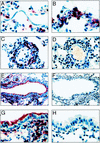An essential role for interleukin-5 and eosinophils in helminth-induced airway hyperresponsiveness
- PMID: 9712797
- PMCID: PMC108535
- DOI: 10.1128/IAI.66.9.4425-4430.1998
An essential role for interleukin-5 and eosinophils in helminth-induced airway hyperresponsiveness
Abstract
Infection with the parasitic helminth Brugia malayi can result in development of a severe asthmatic response termed tropical pulmonary eosinophilia. This disease, thought to result from a host inflammatory response to blood parasites which become trapped in the lung microvasculature, is characterized by a profound eosinophilic infiltration into the lungs. Recruitment of eosinophils also correlates with the development of airway hyperresponsiveness (AHR) to cholinergic agonists and severe asthmatic symptoms. Our studies examined the role of interleukin-5 (IL-5) in helminth-induced pulmonary eosinophilia and AHR. C57BL/6 mice immunized with killed B. malayi microfilariae and challenged intravenously with live microfilariae exhibit many of the characteristics of human disease, including peripheral and pulmonary eosinophilia. Cells recovered by bronchoalveolar lavage of sensitized mice consisted of 3.8% eosinophils on day 1 postchallenge and 84% on day 10. Extracellular major basic protein was present on the surface of airway epithelial cells as early as day 1 and continued to be evident after 8 days, indicating sustained activation and degranulation of eosinophils in the lung. These histologic changes correlated with the development of AHR to carbachol. In contrast to immunocompetent mice, immunization and challenge with B. malayi in IL-5(-/-) mice did not induce peripheral or pulmonary eosinophilia, and these mice failed to show AHR in response to cholinergic agonists. Taken together, these data indicate that IL-5 and eosinophils are required for the induction of AHR by filarial helminths.
Figures



Similar articles
-
Reciprocal immunomodulatory effects of gamma interferon and interleukin-4 on filaria-induced airway hyperresponsiveness.Infect Immun. 2001 Mar;69(3):1463-8. doi: 10.1128/IAI.69.3.1463-1468.2001. Infect Immun. 2001. PMID: 11179313 Free PMC article.
-
Interleukin-12 suppresses filaria-induced pulmonary eosinophilia, deposition of major basic protein and airway hyperresponsiveness.Parasite Immunol. 1998 Oct;20(10):455-62. doi: 10.1046/j.1365-3024.1998.00174.x. Parasite Immunol. 1998. PMID: 9797506 Free PMC article.
-
Eosinophil-Mediated Immune Control of Adult Filarial Nematode Infection Can Proceed in the Absence of IL-4 Receptor Signaling.J Immunol. 2020 Aug 1;205(3):731-740. doi: 10.4049/jimmunol.1901244. Epub 2020 Jun 22. J Immunol. 2020. PMID: 32571840 Free PMC article.
-
Pathogenesis of tropical pulmonary eosinophilia: parasitic alveolitis and parallels with asthma.Respir Med. 1998 Jan;92(1):1-3. doi: 10.1016/s0954-6111(98)90022-1. Respir Med. 1998. PMID: 9519215 Review. No abstract available.
-
Airway hyperresponsiveness: first eosinophils and then neuropeptides.Int J Immunopharmacol. 1997 Sep-Oct;19(9-10):517-27. doi: 10.1016/s0192-0561(97)00085-4. Int J Immunopharmacol. 1997. PMID: 9637348 Review.
Cited by
-
Effect of Natural Products on Commercial Oral Antidiabetic Drugs in Enhancing 2-Deoxyglucose Uptake by 3T3-L1 Adipocytes.Ther Adv Endocrinol Metab. 2011 Jun;2(3):103-14. doi: 10.1177/2042018811411356. Ther Adv Endocrinol Metab. 2011. PMID: 23148176 Free PMC article.
-
Infection outcome and cytokine gene expression in Brugia pahangi- infected gerbils (Meriones unguiculatus) sensitized with Brucella abortus.Infect Immun. 2002 Nov;70(11):5938-45. doi: 10.1128/IAI.70.11.5938-5945.2002. Infect Immun. 2002. PMID: 12379668 Free PMC article.
-
Reduced Leukocyte Infiltration in Absence of Eosinophils Correlates with Decreased Tissue Damage and Disease Susceptibility in ΔdblGATA Mice during Murine Neurocysticercosis.PLoS Negl Trop Dis. 2016 Jun 22;10(6):e0004787. doi: 10.1371/journal.pntd.0004787. eCollection 2016 Jun. PLoS Negl Trop Dis. 2016. PMID: 27332553 Free PMC article.
-
Identification and characterization of a novel nematode pan allergen (NPA) from Wuchereria bancrofti and their potential role in human filarial tropical pulmonary eosinophilia (TPE).PLoS Negl Trop Dis. 2024 Feb 14;18(2):e0011972. doi: 10.1371/journal.pntd.0011972. eCollection 2024 Feb. PLoS Negl Trop Dis. 2024. PMID: 38354188 Free PMC article.
-
Infection with Strongyloides venezuelensis induces transient airway eosinophilic inflammation, an increase in immunoglobulin E, and hyperresponsiveness in rats.Infect Immun. 2002 Nov;70(11):6263-72. doi: 10.1128/IAI.70.11.6263-6272.2002. Infect Immun. 2002. PMID: 12379705 Free PMC article.
References
-
- Ackerman S J. Characterization and function of eosinophil granule proteins. In: Mkino S, Fukuda T, editors. Eosinophils. Biological and clinical aspects. Boca Raton, Fla: CRC Press, Inc.; 1993. pp. 33–74.
-
- Armour C L, Diment L M, Black J L. Relationship between smooth muscle volume and contractile responses in airway tissue. Isometric versus isotonic measurement. J Pharmacol Exp Ther. 1988;245:687–691. - PubMed
-
- Chhabra S, Gaur S. Airway hyperreactivity in tropical pulmonary eosinophilia. Chest. 1988;93:1105–1106. - PubMed
-
- Coffman R L, Seymour B W, Hudak S, Jackson J, Rennick D. Antibody to interleukin-5 inhibits helminth-induced eosinophilia in mice. Science. 1989;245:308–310. - PubMed
Publication types
MeSH terms
Substances
Grants and funding
LinkOut - more resources
Full Text Sources
Medical

